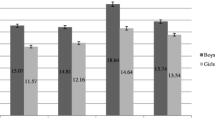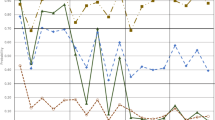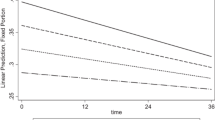Abstract
The aim of this study was to present and initially test a model of escalation to verbal and physical aggression among Israeli youths. Stratified sampling was used to obtain data from 799 students in the 7th, 8th, and 9th grades of junior high schools in a northern Israeli city and its suburbs. A structural equation model (SEM) analysis confirmed that there is a significant positive correlation between the constructs of the so-called escalation preference and capability, and showed that both significantly influenced the escalation pattern. In addition, boys and younger students appeared to demonstrate a higher escalatory tendency than girls and older students. Theoretical and practical implications for professional intervention are discussed.
Similar content being viewed by others
REFERENCES
Al-Haj, M. (1989). Social research on family lifestyles among Arabs in Israel. J. Comp. Fam. Stud. 20: 175-195.
Al-Haj, M. (1991). Education and Social Change Among the Arabs in Israel. The International Center for Peace in the Middle East, Tel-Aviv, Israel.
Arbuckle, J. L. (1999). AMOS (Version 4.0) [Computer software]. Small Waters Corporation, Chicago.
Archer, J. (1996). Sex differences in social behavior: Are the social role and evolutionary explanations compatible? Am. Psychol. 51: 909-917.
Baron, R. B., and Richardson, D. (1994). Human Aggression. Plenum, New York.
Bem, D. J. (1972). Self-perception theory. In Berkowitz, L. (ed.), Advances in Experimental Social Psychology. Academic Press, New York, (Vol. 6, pp. 1-62).
Berkowitz, L. (1993). Pain and aggression: Some findings and implications. Motiv. Emotion, 17: 277-293.
Bjorkqvist, K., Osterman, K., and Lagerspetz, K. M. J. (1994). Sex differences in covert aggression among adults. Aggressive Behav. 20: 27-33.
Boldizar, J. P., Perry, D. G., and Perry, L. (1989). Outcome values and aggression. Child Dev. 60: 571-579.
Brown, J. D., Dykers, C. R., Steele, J. R., and White, A. B., (1994). Teenage room culture: Where the media and identities intersect. Commun. Res. 21(6): 813-827.
Dodge, K. A., Coie, J. D., and Brakke, N. P. (1982). Behavior patterns of socially rejected and neglected preadolescents: The roles of social approach and aggression. J. Abnorm. Child Psychol. 10: 389-410.
Dodge, K. A., Price, J. M., Bachorowski, J. A., and Newman, J. P. (1990). Hostile attributional biases in severely aggressive adolescents. J. Abnorm. Psychol. 99: 385-392.
Eagly, A. H., and Steffen, V. J. (1986). Gender and aggressive behavior: A meta-analytic review of the social psychological literature. Psychol. Bull. 100: 309-330.
Eisikovits, Z., Winstok, Z., and Gelles, R. (2002). Structure and dynamics of escalation from the victim's perspective. Fam. Soc. 83(2): 142-152.
Eron, L. D., Walder, L. O., and Lefkowitz, M. M. (1971). The Learning of Aggression in Children. Little Brown, Boston.
Festinger, L., Riecken, H. W., and Schachter, S. (1959). When prophecy fails. In Maccoby, E. E., Newcomb, T. M., and Hartly, E. L. (eds.), Readings in Social Psychology. Harper & Row, New York. pp. 156-163.
Geen, R. G. (1990). Human Aggression. Brooks/Cole, Pacific Grove, CA.
Geen, R. G. (1998). Processes and personal variables in affective aggression. In Geen, R. G. and Donnerstein, E. (eds.), Human Aggression: Theories, Research and Implications for Social Policy. Academic Press, San Diego, pp. 8-9.
Graham, S., and Hudley, C. (1994). Attributions of aggressive and nonaggressive African-American male early adolescents: A study of construct accessibility. Dev. Psychol. 30: 365-373.
Greenglass, E. R. (1993). The contribution of social support to coping strategies. Appl. Psychol.: Int. Rev. 42: 323-340.
Heider, F. (1958). The Psychology of Interpersonal Relations. Wiley, New York.
Huesmann, L. R. (1988). An information processing model for the development of aggression. Aggressive Behav. 14: 13-24.
Huesmann, L. R. (1998). The role of social information processing and cognitive schema in the acquisition and maintenance of habitual aggressive behavior. In Geen, R. G., and Donnerstein, E. (eds.), Human Aggression: Theories, Research and Implications for Social Policy. Academic Press, San Diego, pp. 73-111.
Josselson, R. (1987). Finding Herself: Pathways to Identity Development in Women. Jossey-Bass, San Francisco.
Keltner, D., Ellsworth, P. C., and Edwards, K. (1993). Beyond simple pessimism: Effects of sadness and anger on social perception. J. Pers. Soc. Psychol. 64: 740-752.
Lagerspetz, K. M. J., and Bjorkqvist, K. (1994). Indirect aggression in boys and girls. In Huesmann, L. R. (ed.), Aggressive Behavior: Current Perspectives Plenum, New York, pp. 131-150.
Lagerspetz, K. M. J., Bjorkqvist, K., and Peltonen, T. (1988). Is indirect aggression typical of females? Gender differences in aggressiveness in 11 to 12 year-old children. Aggressive Behav. 14: 403-414.
Lavee, Y., and Katz, R. (2002). Division of labor, Perceived fairness and marital quality: The effect of gender ideology. J. Marriage Fam. 64 (Feb.): 27-39.
Markus, H., and Nurius, P. (1986). Possible selves. Am. Psychol. 41: 954-969.
Rubin, K. H., Bream, L. A., and Rose-Krasnor, L. (1991). Social problem solving and aggression in childhood. In Pepler, D. J., and Rubin, K. H. (eds.), The Development and Treatment of Childhood Aggression. Erlbaum, Hillsdale, NJ.
Slaby, R. G., and Guerra, N. G. (1988). Cognitive mediators of aggression in adolescent offenders. Part I: Assessment. Dev. Psychol. 24: 580-588.
Smooha, S. (1989). Arabs and Jews in Israel: Conflicting and shared attitudes in a divided society. Westview Press, Boulder, CO.
Snow, D. A., and Anderson, I. (1987). Identity work among the homeless: The verbal construction and avowal of personal identities. Am. J. Sociol. 92: 1336-1371.
Staub, E. (1996). Cultural-societal roots of violence: The examples of genocidal violence and of contemporary youth violence in the United Stated. Am. Psychol. 51: 117-132.
Tanner, J. M. (1970). Physical growth. In Mussen, P. H. (ed.), Carmichael's Manual of Child Psychology (3rd edn., Vol. 1). Wiley, New York.
Tedeschi, J. T., and Felson, R. B. (1994). Violence, aggression, and coercive actions. American Psychological Association, Washington, DC.
Ulman, H., and Tatar, M. (1999). Self-definition, self-esteem, and life satisfaction in veteran Israelis and new immigrants from the former Soviet Union. The Hebrew University of Jerusalem, The Institute for the Study of Educational Development in Israel (Hebrew), Jerusalem, Israel.
Waas, G. A. (1988). Social attributional biases of peer-rejected and aggressive children. Child Dev. 59: 969-992.
Winstok, Z. (2003). The structure and content of verbal and physical aggression among Israeli youth. J. Interpers. Violence. 18(9): 975-998.
Winstok, Z., Eisikovits, Z., and Gelles, R. (2002). Structure and dynamics of escalation from the batterer's perspective. Fam. Soc. 83(2): 129-141.
Author information
Authors and Affiliations
Corresponding author
Rights and permissions
About this article
Cite this article
Winstok, Z., Eisikovits, Z. & Fishman, G. Towards the Development of a Conflict Escalation Model: The Case of Israeli Youth. Journal of Youth and Adolescence 33, 283–292 (2004). https://doi.org/10.1023/B:JOYO.0000032637.13780.14
Issue Date:
DOI: https://doi.org/10.1023/B:JOYO.0000032637.13780.14




